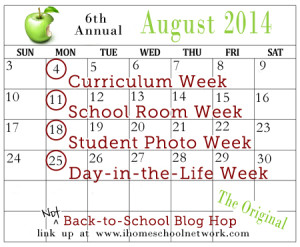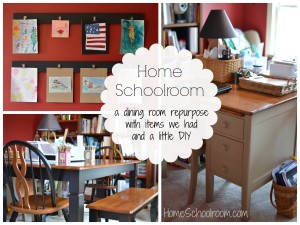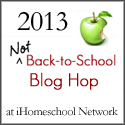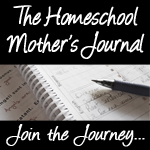 Hi, I'm Heidi and I homeschool my two sweet kids. I want them to know that learning is an exciting lifelong adventure! We love great books, unit studies, notebooking, lapbooking, and hands-on learning.
Hi, I'm Heidi and I homeschool my two sweet kids. I want them to know that learning is an exciting lifelong adventure! We love great books, unit studies, notebooking, lapbooking, and hands-on learning.Tour Our Home Schoolroom
Every year our schoolroom looks a little different. I’m always rearranging things to suit our needs, or on a whim for a fresh look! I rarely buy new things, but constantly move furniture around the house and re-purpose storage pieces. We have a dedicated schoolroom (formerly a dining room), but learning and life are blended so books and educational items are spread throughout the house.
Here’s our schoolroom, spiffed up and ready for September:
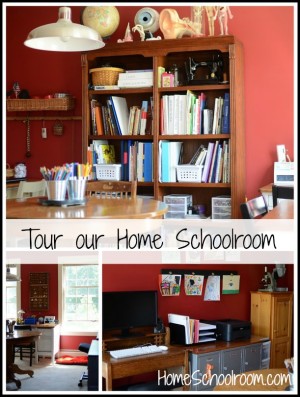
This smallish room forms one corner of our main living area. Before homeschooling I had converted it into an office and craft space for me (heavenly) and painted it a deep red, my favorite color. When it became the schoolroom I considered repainting, but kept it red. The red is warm and keeps this overstuffed room filled with maps, desks, lockers and scientific models still feeling like part of a home. In the 2012 and 2013 schoolroom posts you can see a lot of the same things, though usually in different places.
Rearranging…
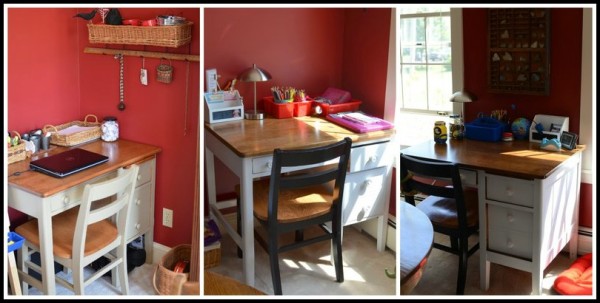
This year our desks are separated, which has given everyone a better sense of their own space. (And cuts down on complaints that some else has papers hanging over onto your desk.)
I moved our small table back in for working together, and also as a space for projects that need to dry, papers waiting to be filed, or the next day’s books awaiting exploration. That helped cut down on clutter in the living areas of our home.
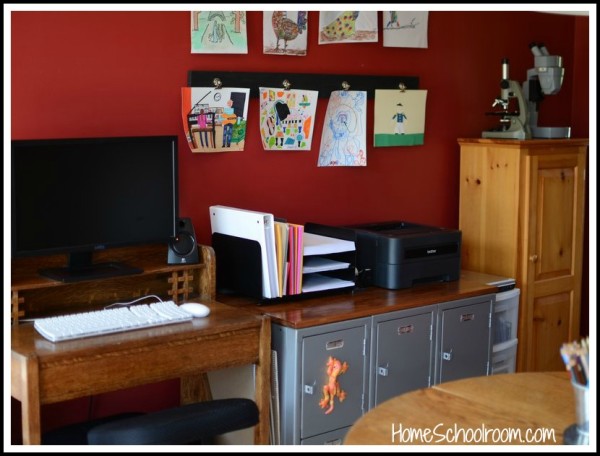
The “command central” wall was rearranged but is still a hub of our storage and activity:
- The most important change was to move the computer into the schoolroom, which tends to be a quieter room for math or writing work.
- My beloved lockers still house a writing center that holds everything the kids need for narrations and notebooking or other writing projects: paper of all sorts, sheet protectors, folders, envelopes, paperclips, index cards, etc.
- The art wall (directions for making it also in my 2012 schoolroom post) is a highlight of the room. It’s an easy way to display and change out their art projects, not to mention a place for wet paintings to dry safe from cat prints.
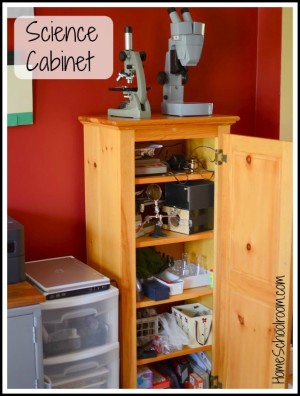
- Another new addition along that wall is a science cabinet: microscopes on top and all the supplies we collect inside: magnifying glasses, goggles, test tubes and beakers, scales…anything to help us feel like real scientists.
Books are EVERYWHERE!
I would love to have those big wall-to-wall bookshelves you see in lots of schoolrooms, but we do pretty well with what we have. Perhaps the fact that wherever my children turn there are books is a good thing! I do have several bookshelves:
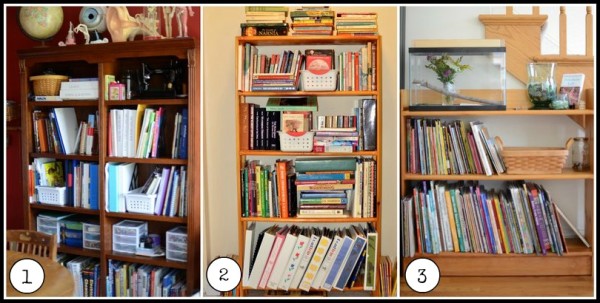
- The main schoolroom shelves holds our curriculum, a cubby space for each child, plus science and history books.
- A low bookshelf holds all our picture books. I use the top shelf for a frequently changing display: temporary pets (creatures my son collects and wants to watch for a few days) or items related to something we’re studying.
- In an upstairs hall is a shelf full of chapter books plus previous year binders. This is getting very full and looking less organized as I start piling. I’ve either got to purge or get more shelf space.
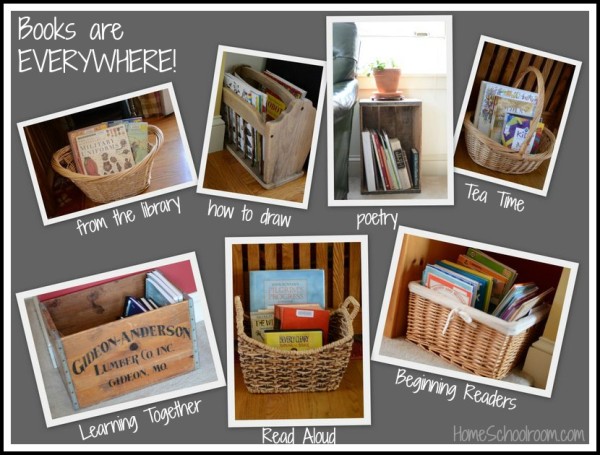
I round out our shelf storage with boxes and baskets of books, tucked into the spaces I think they’ll get the most use or attract the most attention. These smaller pieces are perfect for themed collections like poetry or drawing books, books for specific uses like beginning readers or library books, or books we use at a certain time, like when we’re learning together, during Tea Time, or for reading aloud.
Learning spaces throughout the house…
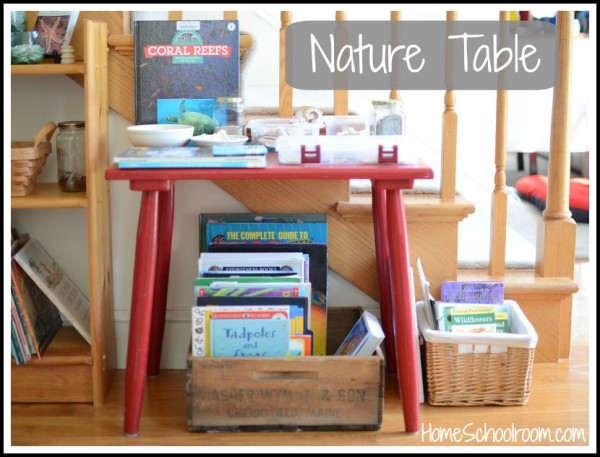
I’ve re-purposed a small children’s table as a nature table, and the low height and location in a walkway works well for catching attention. And look–more boxes and baskets of books! The box contains all our nature-related science books, the smaller basket beside it holds field guides. I add relevant books to the tabletop with the nature items on display.
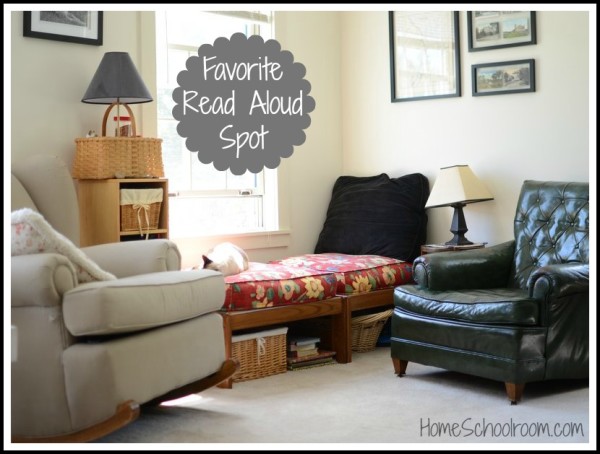
Much of our day (or at least our favorite part of the day) still consists of reading aloud. This nook is a new arrangement of furniture we already had. I like it because it’s a cozy comfortable space and the close proximity of the chairs means I can use a quieter voice. There is room on the floor for our dog (or my son rolling around to get the wiggles out). We read everywhere–the deck, a park, the living room, in the camper, at the dining table…but this is probably my favorite spot.
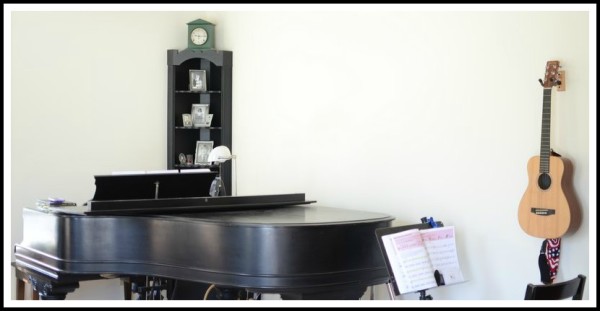
Both my children take music lessons and are lucky to have beautiful instruments to play. It’s a big priority in our homeschool budget. Their instruments have a prominent place in our home and schedule.
Some things stayed the same…
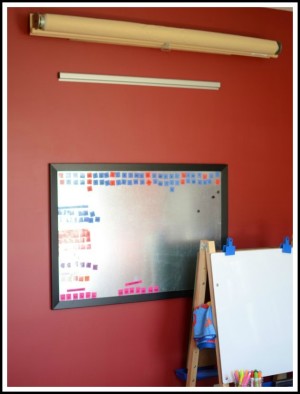
The magnetic board I made three years ago still works wonderfully, now for my son who is using All About Spelling’s magnetic letter tiles. (See my 2012 schoolroom post for directions on the inexpensive DIY magnetic board.) An easel nearby is great for spelling practice, silly notes to each other, vocabulary words for narrations, surprise announcements, or schedule details. Of course I still love my big $5 roll-down wall maps from a school closing sale.
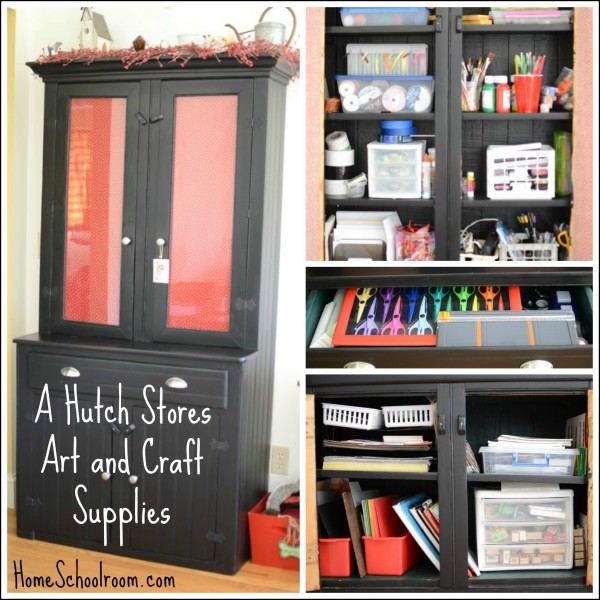
This black hutch, with fabric behind the glass doors to hide the clutter, still stands in as wonderful storage for craft supplies.
Not everything is organized…
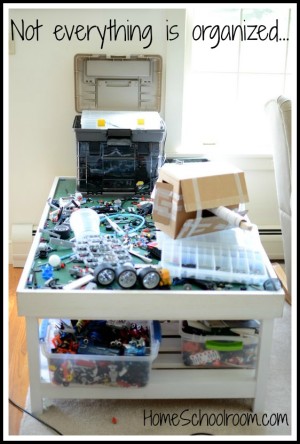
And here’s a real-life photo. We re-purposed the old train table into a Lego Robotics table. We bought a large tackle box to store the thousands of pieces…but that sits empty. My son’s brain works entirely differently from mine, and can work within the chaos. I close my eyes when I walk by!
That’s a current look at our homeschool learning spaces. It’s a pretty good bet that if I took pictures again in a few months things would be moved around again!
Head over to iHomeschool Network to peek into other schoolrooms.
Our Home is Our Schoolroom
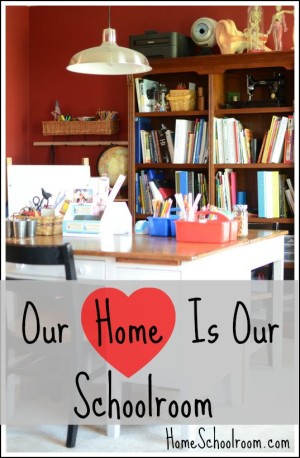
It’s so handy to have a dedicated room to call our schoolroom, but the longer we’re at this the more our “school” and “home” life are merging into one lovely lifestyle. Let me show you some pictures of our schoolroom and the other learning spaces that keep educational and interesting things within my children’s reach at all times.
I shared details about how we transformed our rarely-used dining room into our home schoolroom last year.
We used things we already had and some elbow grease to give new life to old items and in a couple cases make things we needed. In that post you’ll also find the directions for our easy to change art wall and our inexpensive large magnetic board.
Rearranging
We’ve changed a few things around since that post. I confess that I have rearrange-itis. I get urges to rearrange rooms all the time. Being open to repurposing and rearranging is one way I keep costs down…not to mention changing a room around is way more fun than just cleaning!
So, I moved the table we were using for a schoolroom table out into the kitchen. That worked better because we needed more elbow room at dinner time.
The little table from the kitchen became a computer table in our music/playroom. That worked better because my kids needed more room to spread out books and scratch paper beside the computer for Teaching Textbooks.
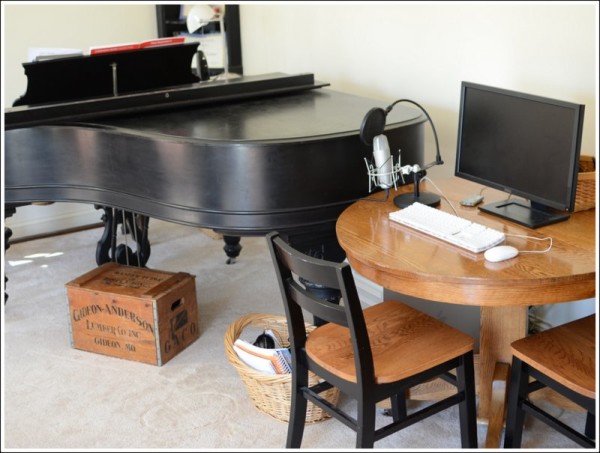
Desks from their rooms came downstairs to the schoolroom. This was a smart move because they rarely used the desks when in their room, and it gave them a lot more storage in the schoolroom. We keep the desks grouped together in the center of the room because we can easily converse and all have a nice view out the window.
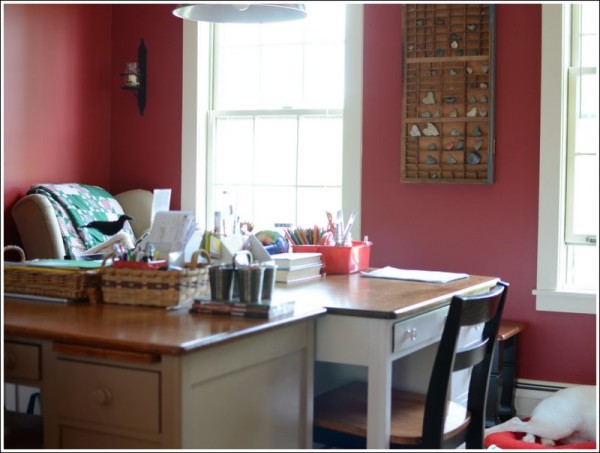
Geography Corner
I gathered all our geography resources to create a central Geography Corner. Now all our geography games, maps, puzzles, and a globe are near our giant pull-down wall maps. (I still nearly swoon when I pull down these maps. Yes, just $5 at a school demolition sale.)
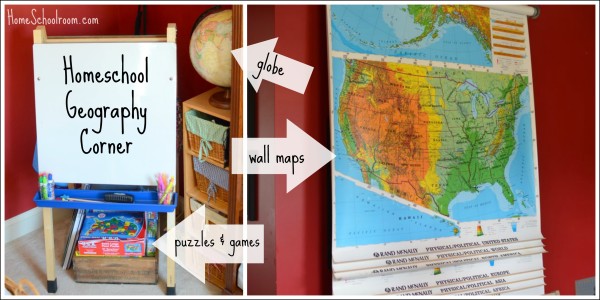
Command Central
I was going to call this area (with my beloved lockers) the writing center, but it has a lot of science and math stuff in it. So I made up something official sounding: Command Central.
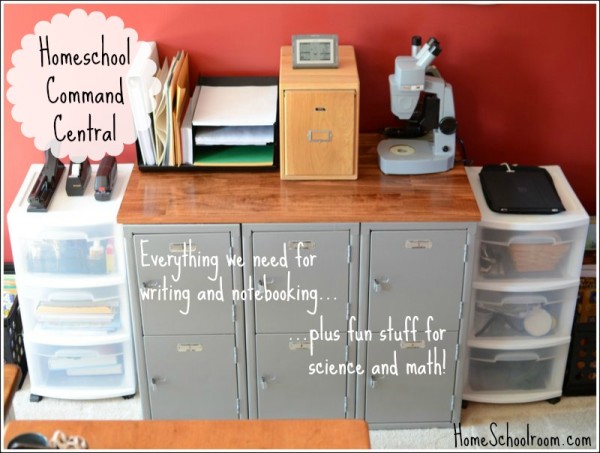
- For writing and notebooking you’ll find lined and unlined paper, envelopes, sheet protectors, a dictionary and thesaurus, stationery, graph and other specialty paper, along with tools like a hole punch and supplies like paperclips. There is a binder that holds notebooking pages my children can choose from if they don’t want to use plain paper. I’ve stocked it with general notebooking pages, plus a few styles of graphic organizers and books reports. I love this system because it keeps notebooking simple–no searching for specific pages online.
- For science there is a microscope and slides, a stereoscope, and all the science supplies that make you feel cool like glass beakers and goggles.
- For math there are manipulatives, scales and balances.
- Plus each child gets their own locker. Don’t let my kids say they’re missing out on any of the fun school kids have! I may even put combination locks on them someday just so when they get older they can have dreams like I do that they’ve forgotten their locker combination.
Bookshelves (You can never have too many.)
The large bookshelf in our schoolroom is packed full, and I organize it by person.
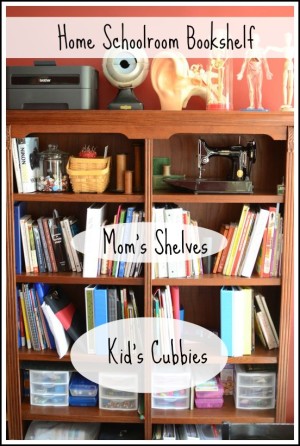
I use two higher shelves for my binders, reference books, teachers manuals and books I’m saving for upcoming units. Each of my children has two shelves: one for books, binders and notebooks, the other for school supplies. This bookcase also houses my sadly under-used sewing machine and on top science models and our printer.
My favorite homeschool supply is books, and there isn’t a room in our house that doesn’t have them. Bookshelves and baskets or boxes of books are everywhere you look in our home.
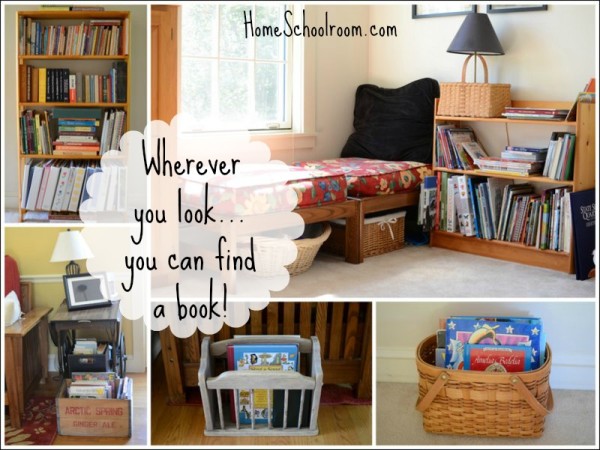
- Nonfiction science and history books are near a window seat. I also keep books here that are just fun to look at like Waldo or spot-the-difference type books.
- Library picture books have their own box beside the couch. Just above them is a box with chapter books and devotional books we’re reading aloud.
- Poetry books are next to a comfortable armchair in the living room.
- Just outside their bedroom doors is a basket of audio picture books we have on audio. My husband has recorded some of our favorite books for our children. They love to listen to his voice reading them!
- In the upstairs hall is a bookshelf of chapter books and our previous year school binders. (Note to self: we need more bookshelves.)
- Each of my children also has a bookshelf in their room for favorite books they’ve collected. In the schoolroom my daughter has her own basket of chapter books she’s working on and my son has a crate of just-right-for-him books.
Nature Table
Our nature table is located in a highly trafficked spot.
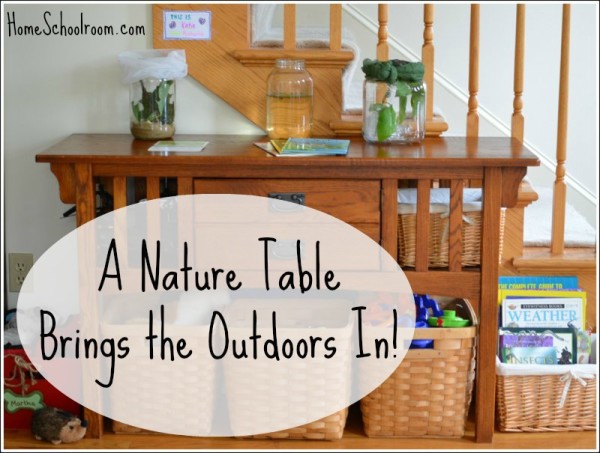
I rotate items through to keep it interesting. In a basket on the floor are all our field guides. I stack books on the table related to what’s on display, sometimes from our collection and sometimes from the library. Items that will keep for a long time but aren’t on display right then I keep in shoe boxes in the basement.
Storing Art and Craft Supplies
Supplies for crafts and art projects reside in a hutch near the kitchen. I shared the supplies I stock to fuel my children’s creativity.

Education is our Life
School spills over into home, and home spills over into school. The schoolroom is a great hub, but our whole house works to enrich our lives. It’s a great place to spend our days.
Need more ideas for organizing your learning spaces? Hop over to iHomeschool Network’s NOT Back to School Blog Hop where everyone is sharing their homeschool rooms.
Still Learning During Break…and a Little Schedule Adjustment Makes a Big Difference
We had a terrific holiday break, and I hope you all enjoyed some wonderful time with family and friends. If you were smart you didn’t enjoy as much fudge as I did. Luckily we finally got the snow my kids have been wishing for, so I also had to do some shoveling!
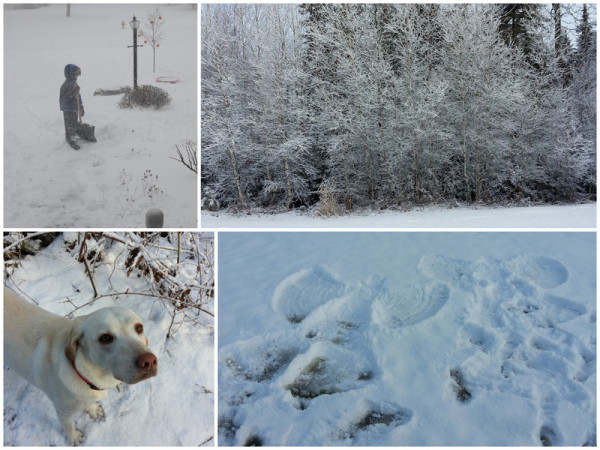
More than one snowfall occurred over break and we took full advantage. My opinion is if it’s going to be cold we might as well have snow–it’s pretty and lots of fun for kids (and dogs!).
I put aside our formal curriculum during December to focus on Christmas activities (which still involved lots of learning), with a plan for nothing but friends, family and fun from the week before Christmas up until the new year. The part I love is that we just can’t stop learning!
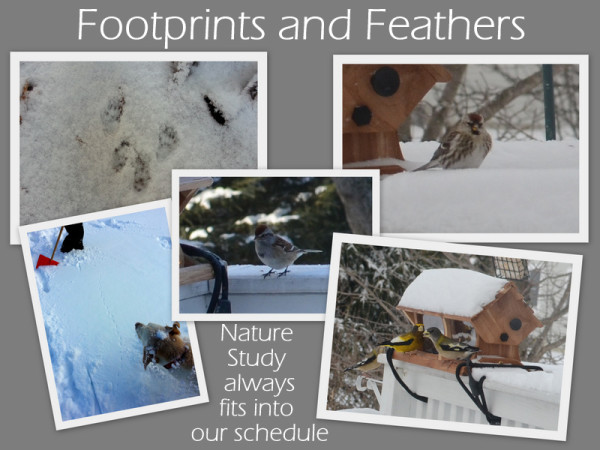
Nature study has become something that occurs just naturally (pardon the pun) for our family! We found tracks to identify in the fresh snowfall and new-to-us birds to look up in my Christmas gift–the Birds of Maine field guide.
We also met (and fell in love with) my brother-in-law’s Turkish girlfriend and asked her a million questions about her country and culture. Luckily she’s patient and loved us right back so hopefully she didn’t mind. The homeschooler in me chuckled at how much we were learning on our vacation!
On New Year’s Eve I was far too tired to think about staying up until midnight. Here’s a trick I’ve used before: use time zones to cheat. We rang in the New Year with London. At 7:00 pm we toasted while watching the fireworks and listening to Big Ben on the BBC.
We also opened our 2012 time capsule. Last year I typed up a quick questionnaire with things like height and weight, favorite shows and activities, and resolutions for the new year. We rolled them up and put them in a paper towel tube and packed them in with our Christmas decorations (so I wouldn’t forget about them…not that I forget things like that…). We had several giggles reading over them. Oh, and I won the award for most weight gained. I wish I was kidding.
We had a lot of fun over the holidays, and the change was long enough that we were ready to jump back into our regular routine. The break was also a good time for me to evaluate things. One area I wanted to address was our morning start time, which seemed to be later than desirable on too many days.
As I read Charlotte Mason’s writings I was reminded that my habits must be in order if I want to pass on good habits to my children. Some self-reflection helped me notice I sometimes get lost on my computer or throw in a load of laundry or do other things and neglect to get myself ready on time. My daughter also takes longer to “beautify” herself (her word choice!) than when she was younger, so she had to make some adjustments to her morning. She and I brainstormed and came up with a workable plan.
I set a time for myself that I must get in the shower and this begins everyone’s “get ready” routine. Sounds simple, but it was necessary–I had embraced the flexibility of homeschooling a little too much! The other change was that in our previous schedule we had breakfast and watched Student News before heading upstairs to get ready for the day, then met back downstairs for school. With the new plan we’ll be getting ourselves ready earlier and then meeting for breakfast and the news once we’re all dressed. Then it’s easy to hop directly into our work!
We’ve had three mornings to try it out, and I must say the mornings are running more smoothly and we’re starting promptly–which leads to finishing our work and all of us having extra time in the afternoon to pursue our interests. I’ll let you know how I do at sticking to this new routine until it’s a habit!
Thank you to the wonderful hostesses with fun link-ups on Fridays. Be sure to join the fun and see what other homeschoolers are up to!
Homeschool Organization: Schedules, Plans and Paperwork…Oh My!
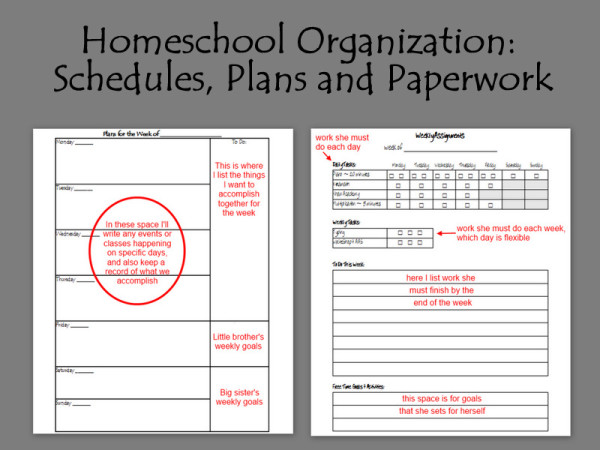 I’ve said it before and I’ll admit it again…I love lists! They make me feel organized and productive. Lists and schedules were one way I calmed my fears as we began homeschooling. I started with a detailed spreadsheet for each week, with time slots in fifteen minute increments, including a little “M” indicating who I would be working with in every block. I know, many of you are chuckling. Go ahead! I can laugh now, too.
I’ve said it before and I’ll admit it again…I love lists! They make me feel organized and productive. Lists and schedules were one way I calmed my fears as we began homeschooling. I started with a detailed spreadsheet for each week, with time slots in fifteen minute increments, including a little “M” indicating who I would be working with in every block. I know, many of you are chuckling. Go ahead! I can laugh now, too.
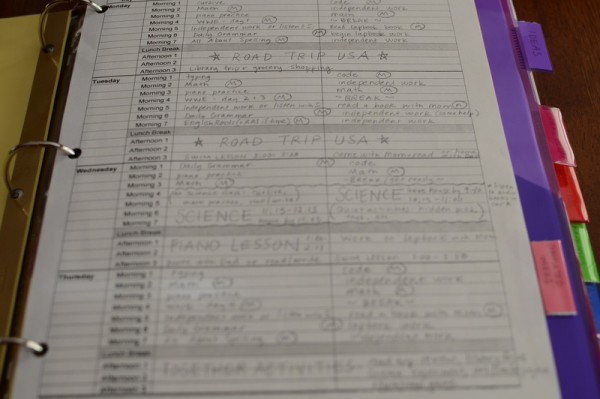
The problem was that instead of the schedule working for me, I was a slave to my schedule (dragging the kids along with me). I relaxed a little at a time until I found the level of organization that worked for me–enough to keep us on track but allow flexibility. Here’s a rundown of what I use now for planning and scheduling:
Monthly Calendars:
For our family my husband and I use Google Calendar. Yes, I fought changing to a computer-based calendar like I fight all new technology, and now I love it. We both stay up to date, and calendar alerts on my phone have saved me numerous times. Scheduled events like field trips, group meetings and classes go in Google Calendar–basically anything that requires us leaving the house.
For homeschool planning I use printable monthly calendars from Donna Young (a terrific site with loads of free resources). It’s a good place to organize my thoughts, and obviously I would clutter up Google Calendar if I added everything we do at home. Here I plan out our general school schedule: which weeks will be full time, part time or off. I write in public school schedules so we know when some of our friends are out of school. I also pencil in things like unit studies (elections/government in the fall, Christmas-related in December…) or special events we may want to celebrate or learn about.
Weekly planners:
I use two weekly planners: one for me, and one for my daughter (age 10). I made these myself in a spreadsheet program (because I already knew how to use it), and they aren’t beautiful, professional-looking forms but they are easy for me to tweak and make changes to as needed.
This is my weekly planner, and you can see I’ve relaxed quite a bit since the tiny boxes with a little “M.” I ended up with my own variation of a weekly planner from Home School Mom (scroll down to “Weekly Planner with To Do List”) with a couple changes: I plan my weeks Monday-Sunday since I usually pull things together for the week on Sunday afternoon, and I divided the “To Do” box so I would have a large area for the work we do together, and a small area for each child.
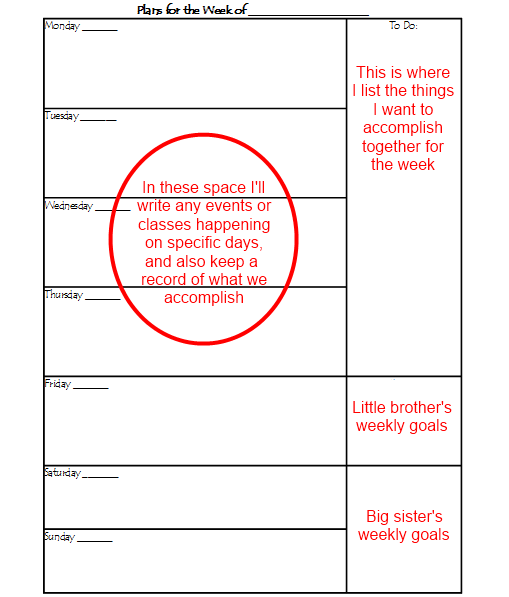
What I like best about this is the flexibility–I can still make my lists and check things off, but we can work through the weekly goals in a flexible manner. We can spend extra time reading aloud if we can’t wait to see what happens next, delve into nature study if the weather is beautiful, or break out the paint or science experiments if I don’t need to worry about the mess that day. Not only that, but it gives me permission to be flexible for the fun things (“Hey kids, Dad wants to take us out to breakfast!”) and the not-so-fun (someone just threw up) without having to scribble all over my lesson plans and schedules.
This year my daughter has her own weekly assignment sheet. Last year I began making her a handwritten list of her independent work each day so she didn’t have to ask what to do next. She enjoyed seeing what she had to do, being able to cross things off (that’s my girl!) and the independence of choosing the order of her work. For part-time summer schoolwork I made her a list for the week instead of the day and it worked even better! It saved me time (hooray!), and if something needed to carry over I didn’t have to rewrite it each day. Subjects like typing could have three check boxes, and she could decide which days to do it. I made her a printable one this year to save time and keep it neat and organized. Repeating subjects are filled in, with room to write assignments like copywork or notebooking. Note that only her individual work is there; combined subjects like science and history are not on her assignment sheet.
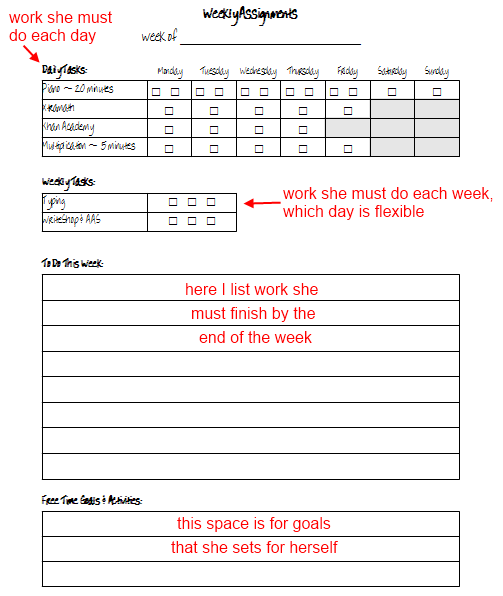
Do you notice the area at the bottom–free time goals and activities? I am excited about this one. My daughter has lots of hobbies (sewing, knitting, writing stories and piano songs), but still sometimes needs help finding things to do on her own when I’m not directing her activities. I made this area for her to do her own list-making, hoping it will help her focus so her free time can be productive.
So there you have it, my scheduling and planning paperwork in a nutshell. Now if only I could organize all the other papers that pile up in our schoolroom…
Our Home Schoolroom 2012
It’s about time I posted about our schoolroom here on Home Schoolroom!
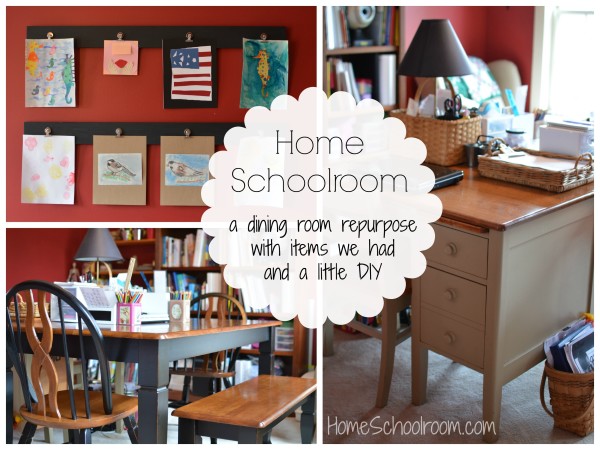
We have a formal dining room in our home…and we aren’t formal dining kind of people. After it sat unused for a couple years, I turned it into my office and crafty space and painted it a deep red. I’d always wanted a red room! It was great because we could work on projects and leave them out. Then we decided to homeschool so now it’s still my office and a crafty space, but it’s also where most of our school supplies reside.
First let me say that not only are we fortunate to have a whole room to use, but that we’ve been very fortunate in finding some or our schoolroom items. I found free or very low cost items when a University was selling old furniture and when there was a sale at an area school when they were moving to a new building. I just had to keep my eyes open and be willing to do a little work to fix up the pieces! I also made a few items and used things we already had to complete our home schoolroom without spending a lot of money. Anyway, on to our room…
In the middle of the room you’ll find our work surfaces. This is my desk. (A lucky find for $15.)
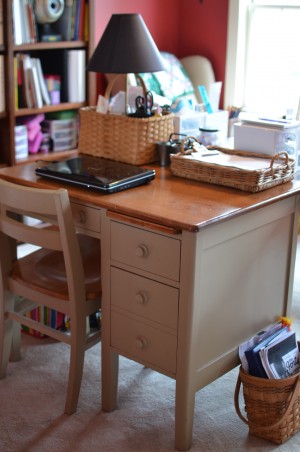
The basket lamp is great for hiding some of my desktop clutter. The shallow basket is a good place to pile my papers that I plan to deal with soon. (Note to self: Deal with the papers in it soon.) There are also baskets on the floor on each side of my desk: one for yet more papers-I-plan-to-deal-with, the other for small sewing and knitting projects. Baskets are a necessity, they make my messes look nice.
This is the schoolroom table (our old dining table) where my children have their own workspace at each end.
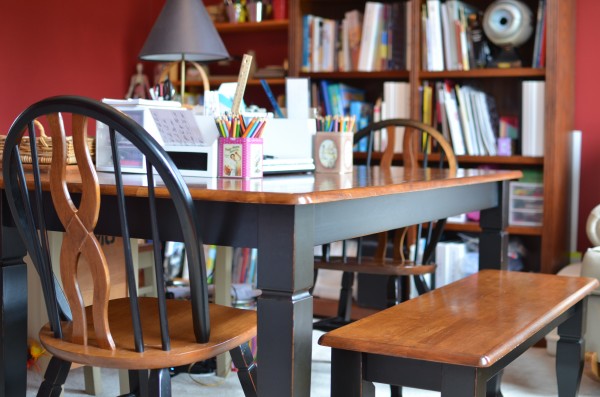
At their workspaces are a wooden organizer and plastic drawer unit, both from Target, to hold pens, pencils, glue runners, a pencil sharpener and anything else to keep them from having to get up a dozen times when they’re working. They also have the 50-count pack of Crayola colored pencils. If you have the money in your homeschool budget I recommend upgrading to that pack. We use colored pencils a lot for lapbooking and notebooking and our nature journals. Having lots of colors to choose from is fun, and I find they work hard to look at the details to choose just the right color from all that variety. The organizers let them have the supplies they need, gives them a defined workspace, and still look cute!
The bench beside the table is perfect. If the three of us are working together on something we all sit there. I hope they’re never too big for that. (And that I’m not either!)
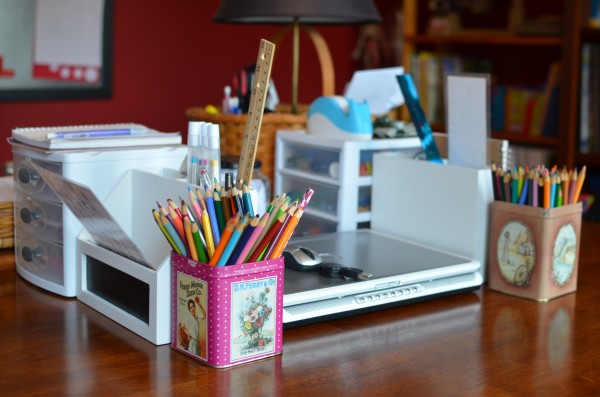
Tucked in between their spaces is my old laptop that they use for typing, Xtramath, Khan Academy and any educational computer games. We just slide it forward as needed.
Directly behind my desk is one of only two large wall spaces, and in a room this small we use every inch by going vertical!
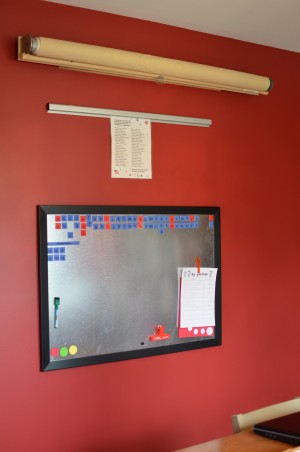
The large magnetic board is used for All About Spelling. Finding a whiteboard that magnets stick strongly to in the size needed wasn’t cheap, so I made this one. It’s easy!
- I purchased a large black frame at AC Moore with a coupon for about $15.
- I had our local sheet metal fabricator cut a piece of galvanized steel to fit (he even let me pick the piece I wanted) for about $20.
- I removed the glass from the frame, slipped the steel in, and replaced the frame’s backing.
And for about $35 it was less than many of the large magnetic whiteboards I saw, and I love the way it looks!
Above that is an Advantus Grip-a-Strip display rail. I use it for maps, posters, timeline cards, art–you simply slip the item between the rails and rollers hold it in place; just push up and then pull down to remove it. The one complaint I have is that laminated items can slip out of the rollers. An easy solution I figured out: place a piece of blue painter’s tape on the top of the item. It doesn’t show but keeps the item from slipping.
Above that is yet another great find from the school sale: a set of roll-up maps (for $5!). I had wanted roll-up maps since I saw them used by Tricia at Hodgepodge as window blinds. Since we’re limited in wall space I thought it was a great idea!
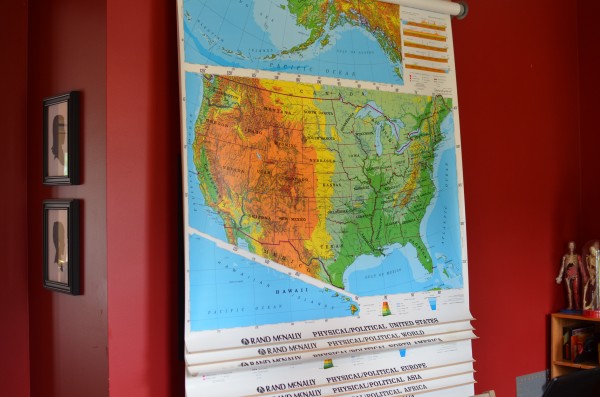
I am in love with these and can’t wait to put them to good use. It took us half a day and around $35 of supplies to mount them, but since they hang right behind my head we wanted to be sure they wouldn’t come crashing down on me.
The wall you see from our kitchen is the “art wall.”
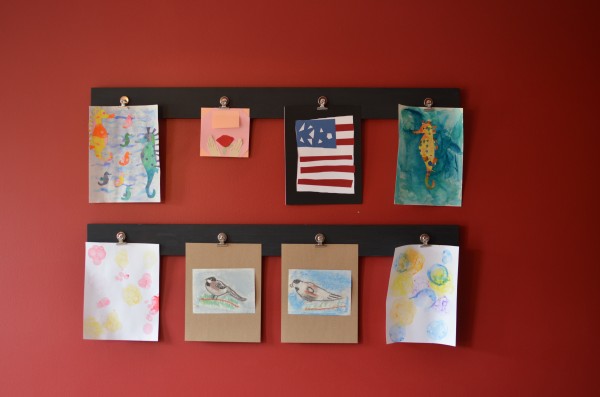
The rails make it easy to change out the artwork, and they were simple and inexpensive to make:
- Paint two long boards
- Use Liquid Nails to glue on some clips
- Install picture hangers on the back of the board.
Voila! A perfect place to enjoy the kids’ art for a while before it goes into their binders. (And a good drying place for wet art so the cat can’t walk on it!)
Below the art wall is our writing center. I was excited to organize our materials into a writing center after reading through the WriteShop teacher’s manual. For us this area is actually a combination writing, notebooking & lapbooking center.
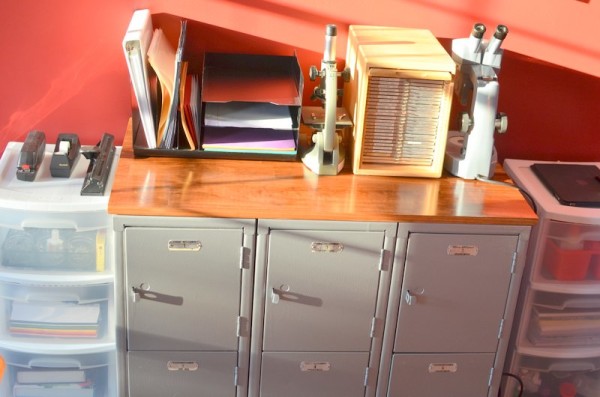
The base is my new favorite piece of furniture: a set of lockers I scored for $10 at the school sale! Some elbow grease and spray paint were all they needed to be the perfect storage piece for a home schoolroom. Beside them are plastic drawer units. (I’ve collected half a dozen over time and am always moving them around using them for different things).
Two lockers are reserved for my children as their writing cubbies. On top of the lockers is a desktop organizer for paper (lined, plain and colored), envelopes, file folders, sheet protectors, and a binder with notebooking pages to choose from. {Note: so far all my notebook pages have been free. Most are from The Notebooking Fairy, Homeschool Share, the Handbook of Nature Study Blog, and abcteach.} Other supplies in our writing/notebooking/lapbooking center are all sorts of paper (cardstock, printed scrapbook paper, stationery, specialty papers), papercrafting supplies (trimmers, fancy edge scissors, paper punches, adhesives, brads, stickers), a dictionary and thesaurus.
There are a few items in this section that are science related. (I had to overcome the organizer in me who really likes to stick with the theme.) One drawer holds experiment tools: goggles, beakers and test tubes–the stuff that helps us feel like real scientists. And on top of my lovely lockers sits two new-to-us very exciting items that we picked up at the school sale: a compound microscope (along with a wooden box to store slides) and a stereo microscope that will be helpful for examining interesting things we find.
On the opposite wall is a row of bookshelves (yup, all different sizes and wood finishes–use what you have).
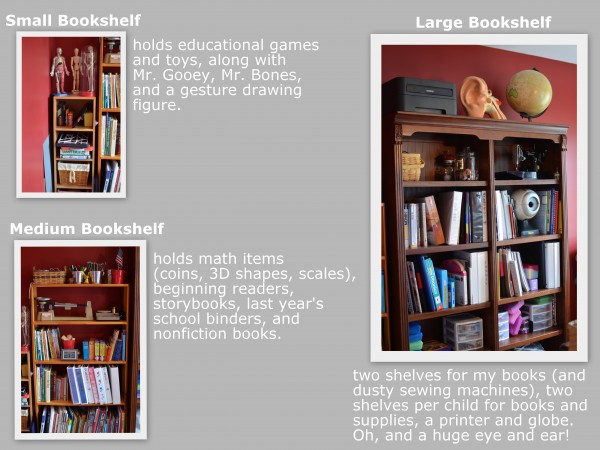
In case you’re wondering, “Mr. Gooey” is a human body model with squishy organs, and “Mr. Bones” is a skeleton model that came with a book from Workman Publishing. Sorry I can’t give you an inexpensive source for the eye and ear: we got them for FREE at the school sale.
As you can see from my description of the schoolroom table, writing center and bookshelves I like giving the kids their own spaces: they like the ownership, and it’s nice to call for a “cubby clean-out” and have them be responsible for their areas.
This last photo shows the home part of the schoolroom: our dog’s bed, our cat’s cube, and a big comfy rocking chair.
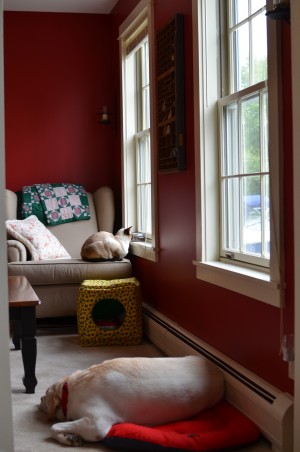
The rocking chair was the one I rocked my babies in and now makes a great quiet corner to read. I can even still squeeze in with one child to work on something together. In small jars on the windowsill beside the rocker is our collection of sea glass from our ocean-side camping trips. On the wall between the windows is an antique printer’s tray that with a very special collection of heart shaped rocks that we’ve gathered for years. These are the items that bring the love of our family into our schoolroom.
Of course our “school” items spill over into the house. Nature field guides and binoculars are in the living room, a large hutch in the hallway holds the messier art supplies and educational games, and chapter books are in a bookcase outside our bedrooms. A lot of schoolwork takes place outside of this defined room: reading on a blanket on the lawn or cozy next to the fire, nature journaling on a walk in the woods, science experiments and art projects on the kitchen island…learning can happen anywhere!
I’m linking up over at iHomeschool Network’s Not Back to School Blog Hop. Click over to check out other schoolrooms!
Changing My Mind About Report Cards
I had no plans to give my children a report card. I don’t give tests or come up with grades, and besides, I’m the mom and teacher, so who is a report card really for? Isn’t it to tell the parents how their child is doing? Then I was reading on Harmony Art Mom (by the same Barb I’m always mentioning from the Handbook of Nature Study blog–she’s just overflowing with ideas I love) and she referred to a post on narrative report cards. I had to click on the post link and read it, and was immediately persuaded that it was a great idea. My favorite part was how Barb included information about topics other than the basic school subjects in her report card: things like field trips and volunteer work.
Barb has a great sample narrative report card at the bottom of her post, and I followed much of her format with a few variations. For one thing, I don’t have a cool school name or logo–maybe I need one! Secondly, like I said, I don’t give grades and we certainly don’t have credits. I also only intend to do one report card per year. I listed the subject areas very generally: Language Arts, Math, Science, Social Studies, Music, Art, Health/P.E., and then had a space for a narrative in each area. On each of the subject areas I would list how we covered the topics, including curriculum used, any curriculum changes and why, what we accomplished, and goals as we go forward. I also could add in if there is a lot of good effort, or if the attitude could use a little improvement. Then I listed other areas: field trips, literature lapbooks, unit studies, volunteer work, and personal development. Personal development was a fun one that allowed me the freedom to discuss their passions. For example, my daughter sewed a lot this year and really advanced her skills. She took classes, sewed with me, and also attempted (and completed) projects on her own. I appreciated being able to include that kind of information.
It did take a bit of time for me to put together, but it became a wonderful summary of our year: a journal of learning and activities, things accomplished and also things to work on in the future. Reading it over I was proud of all we had done, and I know my children and I will enjoy looking back in years to come.
